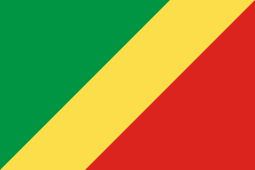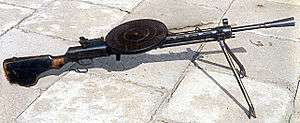Degtyaryov machine gun
| DP Machine Gun | |
|---|---|
|
DP | |
| Type | Light machine gun |
| Place of origin | Soviet Union |
| Service history | |
| In service | 1928–1960s (USSR) |
| Used by | See Users |
| Wars |
Spanish Civil War Winter War World War II Second Sino-Japanese War Korean War Chinese Civil War First Indochina War Vietnam War Laotian Civil War Cambodian Civil War Cambodian-Vietnamese War Rhodesian Bush War Sino-Vietnamese War Yugoslav Wars Somali Civil War 2011 Libyan civil war Syrian civil war |
| Production history | |
| Designer | Vasily Degtyaryov |
| Designed | 1927 |
| Produced | 1928–1950s (USSR) |
| Number built | 795,000 [1] (all variants) |
| Variants |
DP DPT DPM DPA DTM-4 RP-46 Type 53 |
| Specifications | |
| Weight |
9.12 kg (20.11 lb) (unloaded) 11.5 kg (25 lb) (loaded) |
| Length |
DP, DPM – 1,270 mm (50.0 in) RP-46 – 1,272 mm (50.1 in) |
| Barrel length |
DP, DPM – 604 mm (23.8 in) RP-46 – 605 mm (23.8 in) |
|
| |
| Cartridge | 7.62×54mmR |
| Action | Gas-Operated |
| Rate of fire |
550 rpm 2400 rpm (DTM-4) |
| Muzzle velocity | 840 m/s (2,755 ft/s) |
| Effective firing range | 800 m (874.9 yd) |
| Feed system |
47-round pan 60-round pan (DT & DTM) belt feed (RP-46) 30-round overhead box magazine (PD-36 and DTM-4) |
| Sights | Empty circle |
The Degtyaryov machine gun (Russian: Пулемёт Дегтярёвa Пехотный Pulemyot Degtyaryova Pekhotny "Degtyaryov's infantry machine gun") or DP is a light machine gun firing the 7.62×54mmR cartridge that was used primarily by the Soviet Union starting in 1928. The DP machine gun was supplemented in the 1950s by the more modern RPD machine gun and entirely replaced in Soviet service by the general purpose PK machine gun in the 1960s.
Design
The DP-27 was an improvement of the earlier DP-26, both designed by Vasily Degtyaryov. The DP-27 was relatively cheap and easy to manufacture – early models had fewer than 80 parts. The DP was especially able to withstand dirt in a reliable fashion. In tests it was buried in sand and mud and was still capable of firing more than 500 rounds. One of the DP's main drawbacks though was its bipod; it could not withstand much abuse and broke easily.[1] Furthermore, the recoil spring was located under the barrel, around the gas piston; this was one of the design problems of the DP, since the spring tended to lose its temper due to overheating.[2] Also, the only magazine option, a pan with 47 rounds that fed in from the top, was relatively small and continuous fire for long periods could not be relied on as much as contemporary belt-fed weapons. The ammunition was troublesome for automatic fire. Degtyarov had to use a flat pan magazine, which could feed those cartridges reliably, but was too heavy itself, uncomfortable to carry and prone to damage.[2] Due to the design of the magazine, reloading an empty magazine with cartridges took a very long time. A redeeming factor was that the DP's lower cyclic rate of fire did reduce the risk of barrel overheating.
History
Despite its numerous problems, the DP had a reputation as a relatively effective light support weapon. It was nicknamed the "Record player" (proigryvatel') by Red Army troops because the disc-shaped pan magazine resembled a gramophone record and its top cover revolved while the weapon was fired. Many were captured by the Finnish army in the Winter War and the Continuation War and partially replaced the Lahti-Saloranta M/26. The DP received the nickname Emma in Finnish service after a popular waltz, again due to the magazine's resemblance to a record player. In the summer of 1944, the Finnish army had about 3400 Finnish-made Lahti-Salorantas and 9000 captured Soviet-made Degtyarevs on the front.
The Chinese Nationalists received 5,600 DPs from the USSR and used them in the Second Sino-Japanese War and the Chinese Civil War. The Chinese Communists used the DP in the Korean War and copied the DPM as the Type 53.
A number of the RP-46 variant of the DP have been spotted in present-day Somalia, in use with militant forces, and also among rebel forces in the 2011 Libyan uprising to overthrow Muammar Gaddafi.[3]
DP-28's have also been recovered from Taliban fighters in Helmand Province, Afghanistan as recently as 2014.
DPs or DPMs have been spotted in 2014 in the Northern Mali conflict.[4]
Variants
- DPM, modernized version adopted in 1943–44, with a more robust bipod fastened to the cooling jacket and the recoil spring housed in a tube projecting from the rear of the receiver which necessitated a pistol grip for this model of the weapon (manufactured in China as the Type 53)
- DA, for mounting in aircraft (Дегтярёва авиационный, Degtyaryova Aviatsionny; ДА). Also used in tandem mounts known as DA-2. Employed in the early versions of the Tupolev TB-3 bomber and in the Polikarpov R-5 and Polikarpov Po-2 fighters. The DA weighted 7.1 kg empty and 11.5 kg with standard ammunition load. Its rate of fire was 600 rounds per minute. It was built between 1928 and March 1930 with 1,200 units delivered.[5] It was soon superseded by the ShKAS, which had a much higher rate of fire.
- DT and DTM, for mounting in armoured fighting vehicles (Дегтярёва танковый, Degtyaryova Tankovy; ДТ and ДТМ)
- DTM-4, (ДТМ-4) quad mounted variant.[6]
- RP-46 (Ротный пулемет - company machine gun): metallic-belt fed version adopted in 1946 with a heavier barrel to allow prolonged sustained fire. About 500 rounds could be fired continuously before the barrel had to be swapped or wait for it cool down. Also had a user-adjustable gas system, with three holes of varying diameters provided, to cope with varying environmental conditions and residue buildup. Although the empty weight of the RP-46 exceeded that of DP by 2.5 kg, when considered together with a single ammo box of 250 rounds, the RP-46 weighed 10 kg less than the DP together with the same amount of ammunition in DP pans. The RP-46 remained in Soviet service for 15 years before it was replaced (together with the SGM) by the PK machine gun. The RP-46 was later manufactured in China as the Type 58 and in North Korea as the Type 64.[7] The RP-46 could still fire from DP-style magazines by removing its belt-feeding system.[8]
The original DP is more commonly called the DP-28 (or DP-27), although there is some confusion as to whether these are official designations or not.
Users
 Albania: RP-46 variant.[9]
Albania: RP-46 variant.[9] Algeria: RP-46 variant.[9]
Algeria: RP-46 variant.[9] Angola: RP-46 variant.[9]
Angola: RP-46 variant.[9] Benin: RP-46 variant.[9]
Benin: RP-46 variant.[9] Bulgaria
Bulgaria Central African Republic: RP-46 variant.[9]
Central African Republic: RP-46 variant.[9] Republic of China
Republic of China People's Republic of China[10]
People's Republic of China[10] Comoros: RP-46 variant.[9]
Comoros: RP-46 variant.[9] Congo-Brazzaville: RP-46 variant.[9]
Congo-Brazzaville: RP-46 variant.[9] Cuba: RP-46 variant.[9]
Cuba: RP-46 variant.[9] Equatorial Guinea: RP-46 variant.[9]
Equatorial Guinea: RP-46 variant.[9] Ethiopia: RP-46 variant.[9]
Ethiopia: RP-46 variant.[9] Finland: Used captured examples during World War II.[11]
Finland: Used captured examples during World War II.[11].svg.png) Nazi Germany: Captured models were issued to the Volkssturm.[12]
Nazi Germany: Captured models were issued to the Volkssturm.[12] Hungary: DP, DPM and DTM variant[13]
Hungary: DP, DPM and DTM variant[13] Laos: RP-46 variant.[9]
Laos: RP-46 variant.[9] Libya: RP-46 variant.[9]
Libya: RP-46 variant.[9] Nigeria: RP-46 variant.[9]
Nigeria: RP-46 variant.[9] North Korea: RP-46, DPM variant.[14]
North Korea: RP-46, DPM variant.[14] Poland: Used in World War II throughout the Cold War era.
Poland: Used in World War II throughout the Cold War era. Seychelles: RP-46 variant.[9]
Seychelles: RP-46 variant.[9] Somalia: RP-46 variant.[9]
Somalia: RP-46 variant.[9] Soviet Union[10]
Soviet Union[10] Sudan: RP-46 variant.[9]
Sudan: RP-46 variant.[9] Tanzania: RP-46 variant.[9]
Tanzania: RP-46 variant.[9] Togo: RP-46 variant.[9]
Togo: RP-46 variant.[9]
In popular culture
-In the 2015 shooter Tom Clancy's Rainbow Six Siege, it is featured as Alexsandr "Tachanka" Senaviev's Unique Gadget, attached to a rotary tripod. It is wrongly listed as the RP-46 variant, but Tachanka himself refers to it correctly. - in "For Whom the Bell Tolls" by Hemingway
See also
References
- 1 2 "Degtyarev DP LMG (DP28) - Light Machine Gun - History, Specs and Pictures - Military, Security and Civilian Guns and Equipment". militaryfactory.com. Retrieved 2015-09-03.
- 1 2 "Modern Firearms - Degtyarov DP DPM RP-46". world.guns.ru. Retrieved 2015-09-03.
- ↑ "'Stop the unjust war on Libya... and good luck with the election: Gaddafi's rambling, error-strewn letter to Barack Obama". dailymail.co.uk. Retrieved 2016-03-04.
- ↑ "Small arms recovered in Mali raid | Armament Research Services". armamentresearch.com. Retrieved 2015-09-03.
- ↑ Широкорад А.Б. (2001) История авиационного вооружения Харвест (Shirokorad A.B. (2001) Istorya aviatsionnogo vooruzhenia Harvest. ISBN 985-433-695-6) (History of aircraft armament), page 70
- ↑ "Image: 2010051007.jpg, (440 × 358 px)". bratishka.ru. 2010-09-03. Retrieved 2015-09-03.
- ↑ Семен Федосеев (2009). Пулеметы России. Шквальный огонь. Яуза / Коллекция / ЭКСМО. pp. 322–327. ISBN 978-5-699-31622-9.
- ↑ Small Arms Identification and Operation Guide--Eurasian Communist Countries, Defense Intelligence Agency ST-HB-07-03-74, p. 238
- 1 2 3 4 5 6 7 8 9 10 11 12 13 14 15 16 17 18 Jones, Richard D.; Ness, Leland S., eds. (January 27, 2009). Jane's Infantry Weapons 2009/2010 (35th ed.). Coulsdon: Jane's Information Group. ISBN 978-0-7106-2869-5.
- 1 2 Degtyarev DP DPM RP-46 (Russia / USSR) at world.guns.ru
- ↑ Soviet Machine guns and Light Machine guns in the Winter War at winterwar.com
- ↑ W. Darrin Weaver (2005). Desperate Measures: The Last-Ditch Weapons of the Nazi Volkssturm. p. 329. ISBN 0889353727.
- ↑ Lugosi, József (2008). "Gyalogsági fegyverek 1868–2008". In Lugosi, József; Markó, György. Hazánk dicsőségére: 160 éves a Magyar Honvédség. Budapest: Zrínyi Kiadó. p. 384. ISBN 978-963-327-461-3.
- ↑ "NORTH KOREA COUNTRY HANDBOOK | MARINE CORPS INTELLIGENCE ACTIVITY" (PDF). 2 November 1998. Retrieved 2015-09-03.
External links
| Wikimedia Commons has media related to Degtyarev light machine gun. |
| Wikimedia Commons has media related to RP-46. |
- The Battles of the Winter War
- Modern Firearms – Degtyarev DP DPM RP-46
- Soviet DT-28 Repair and Operation Manual(Russian)
- Degtyarov machine gun variants(Russian)
- Degtyaryov machine gun with Japanese Type 11 magazine hopper
- "75 лет ручному пулемёту Дегтярёва" (PDF). 22 April 2010. Retrieved 2015-09-03.
